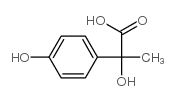DL-p-Hydroxyphenyllactic acid

DL-p-Hydroxyphenyllactic acid structure
|
Common Name | DL-p-Hydroxyphenyllactic acid | ||
|---|---|---|---|---|
| CAS Number | 6482-98-0 | Molecular Weight | 182.17300 | |
| Density | 1.404 g/cm3 | Boiling Point | 414.4ºC at 760 mmHg | |
| Molecular Formula | C9H10O4 | Melting Point | N/A | |
| MSDS | Chinese USA | Flash Point | 218.6ºC | |
| Symbol |

GHS07 |
Signal Word | Warning | |
|
Characteristic urine organic acid profile in peroxisomal biogenesis disorders.
J. Inherit. Metab. Dis. 23(4) , 425-8, (2000)
|
|
|
Production of aromatic alpha-hydroxyacids by epimastigotes of Trypanosoma cruzi, and its possible role in NADH reoxidation.
FEMS Microbiol. Lett. 118(1-2) , 89-92, (1994) Epimastigotes of Trypanosoma cruzi in culture produce and excrete into the medium small amounts of phenyllactic acid and p-hydroxyphenyllactic acids, presumably arising from the catabolism of the aromatic amino acids phenylalanine and tyrosine, respectively. ... |
|
|
Production of 4-hydroxyphenyllactic acid by Lactobacillus sp. SK007 fermentation.
J. Biosci. Bioeng. 109(4) , 369-71, (2010) The production of 4-hydroxyphenyllactic acid (4-HO-PLA), a novel antifungal compound, was studied in Lactobacillus sp. SK007 growth. When grown in MRS broth, the strain could produce 75 microg/ml HO-4-PLA, which was the highest reported so far. Tyrosine and 4... |
|
|
Facile synthesis of optically pure (S)-3-p-hydroxyphenyllactic acid derivatives.
Amino Acids 33(3) , 537-41, (2007) Optically pure (S)-3-p-hydroxyphenyllactic acid derivatives are important intermediates of peroxisome proliferator-activated receptor alpha/gamma dual agonists and heteropeptides. Many efforts have been made for synthesis of those intermediates, but there exi... |
|
|
Tyrosine-derived 4-hydroxyphenylpyruvate reacts with ketone test fields of 3 commercially available urine dipsticks.
Vet. Clin. Pathol. 39(3) , 354-7, (2010) The enzyme 4-hydroxyphenylpyruvate dioxygenase (HPPD) is key in tyrosine catabolism. Inhibition of HPPD results in tyrosinemia and increased urinary excretion of 3 phenylketones: 4-hydroxyphenylpyruvate (HPPA), 4-hydroxyphenyllactate (HPLA), and 4-hydroxyphen... |
|
|
Does vitamin C intake influence the rate of tyrosine catabolism in premature babies?
Ann. Nutr. Metab. 38(3) , 166-73, (1994) A study was conducted to investigate the relationship between vitamin C intake and the rate of tyrosine catabolism in premature babies. A 13C tyrosine breath test was developed for the measurement of tyrosine catabolism. Premature babies were randomly allocat... |
|
|
Simultaneous determination of vanillylmandelic, homovanillic and 5-hydroxyindoleacetic acids in human urine by thin layer chromatography.
Biomed. Chromatogr. 10(3) , 144-5, (1996) A TLC method for the simultaneous analysis of vanillylmandelic, homovanillic and 5-hydroxyindole-3-acetic acids in urine is described. The sample is cleaned up through a cyano minicolumn and extracted with diethyl ether. The acids are resolved by high-perform... |
|
|
Plantar keratoderma: a manifestation of tyrosinemia type II (Richner-Hanhart syndrome).
Ann. Saudi Med. 25(5) , 422-4, (2005)
|
|
|
Inhibition of 4-hydroxyphenylpyruvate dioxygenase by 2-(2-nitro-4-trifluoromethylbenzoyl)-cyclohexane-1,3-dione and 2-(2-chloro-4-methanesulfonylbenzoyl)-cyclohexane-1,3-dione.
Hum. Exp. Toxicol. 15(2) , 179-81, (1996)
|
|
|
Microbial origin of phenylcarboxylic acids in the human body.
Biochemistry. (Mosc.) 74(12) , 1350-5, (2009) In previous studies we demonstrated increased amounts of phenylcarboxylic acids (PCA) in serum of patients with sepsis. This observation prompted the present study of the ability of the human microbiome bacteria to produce PCA in vitro. PCA were detected in c... |